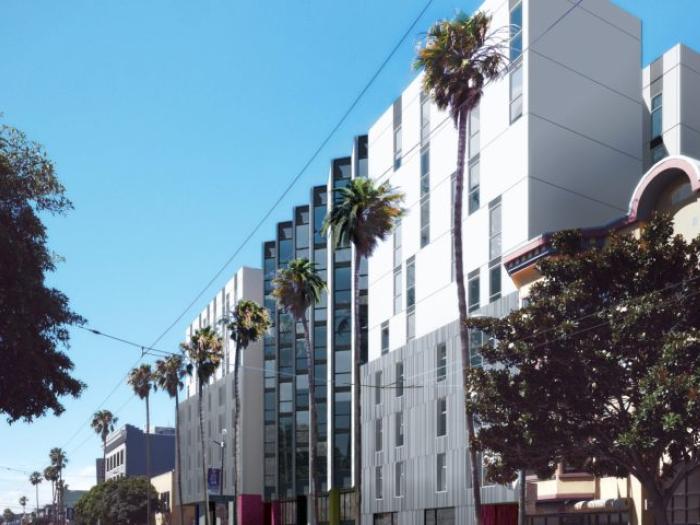
Affordable Housing Bonus Program (AHBP)
Project Status: Completed
On July 29, 2016, Mayor Ed Lee Signed the 100% Affordable Housing Bonus Ordinance into law. Design Guidelines for AHBP 100% Affordable Projects were also adopted.
October 2017: the supplemental application for the 100% AHBP is now available!
The AHBP is a program to increase the amount of affordable housing built in San Francisco. The program offers housing developers incentives, including inceased density and height, in return for building more permanently affordable homes into their projects.
AHBP offers several options, indicated as follows:
Currently

The current program target for permanently affordable is 12%, with no bonus height.
State Program
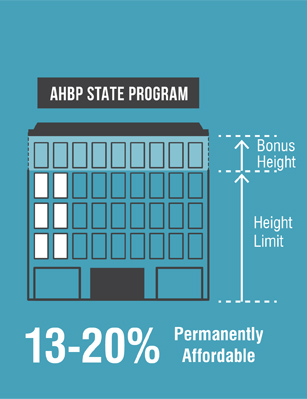
The State AHBP incorporates one of the options available through the Inclusionary Housing Program. To participate in the State AHBP, projects must include 12 percent on-site affordable housing units and up to an additional eight percent affordable housing units on-site for very low-, low- or moderate-income households. These projects will be offered specific incentives: an increased density bonus and up to two additional stories, but only when it is necessary to accommodate increased density. Incentives are offered on a graduated scale, commensurate with the amount of affordable housing included.
This program is referenced as ‘The State Program’ because it is intended to locally implement the State Density Bonus Law. Under this program, projects cannot exceed a 35 percent increase in potential residential density.

Local Program 30% Permanently Affordable
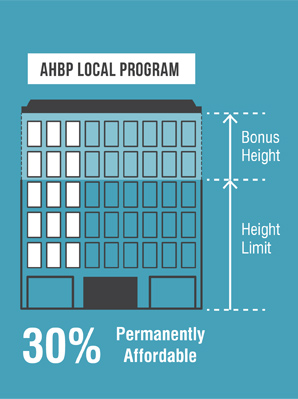
The Local AHBP will offer incentives to project sponsors that elect to provide 30 percent or more affordable housing units on-site. Of this 30 percent, 12 percent must be permanently affordable to low- and moderate-income households and 18 percent permanently affordable to middle-income households. Learn more about the definition of income levels here. If a project has nine or fewer housing units it is not subject to inclusionary housing requirements; therefore it must include a minimum of 30 percent of units affordable to middle-income households.
Projects that include 30 percent or more affordable units for low and middle-income households will be able to build more residential units and up to an additional two stories than currently allowed under existing zoning regulations. Two-bedroom units must make up a minimum of 40 percent of the total number of housing units in the building. The Local AHBP does not have a minimum housing unit threshold.
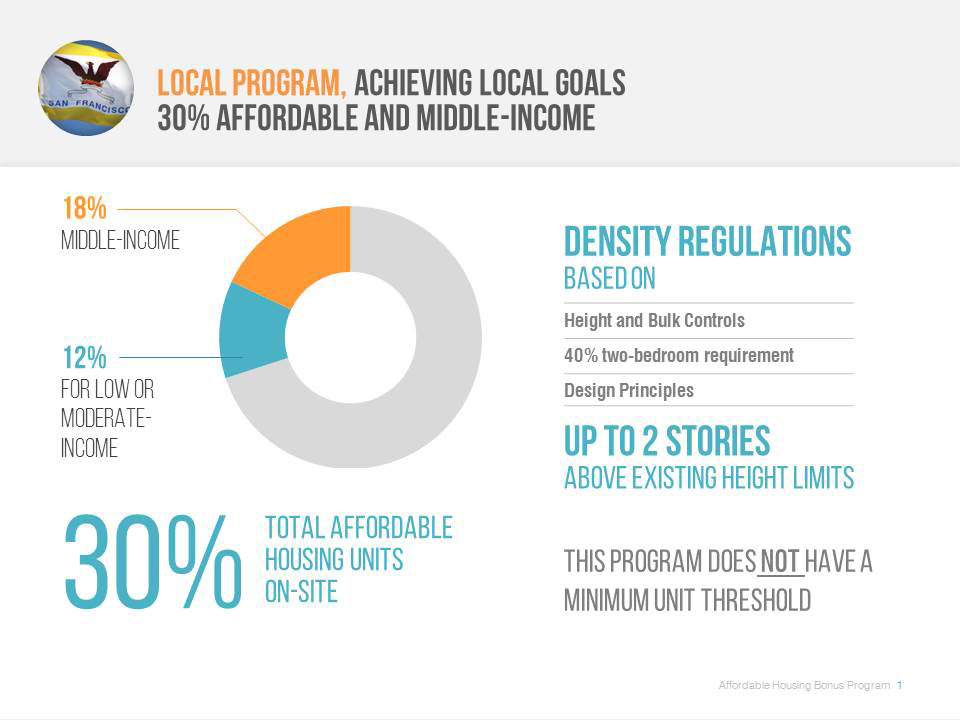
Local Program 100% Permanently Affordable
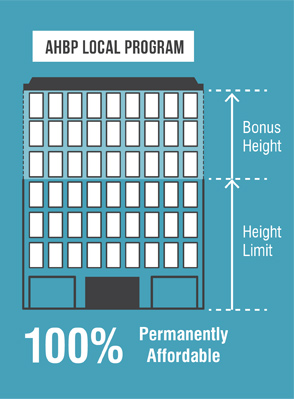
The Local AHBP includes special incentives for 100% affordable housing developments. These projects are generally built by non-profit developers, and usually require public subsidies. The AHBP is available to such projects which provide housing to households making 80% of AMI or less. Learn more about the definition of income levels here.
Projects with 100 percent affordable units will be able to build more residential units and up to three additional stories of residential development than currently allowed under existing zoning regulations.
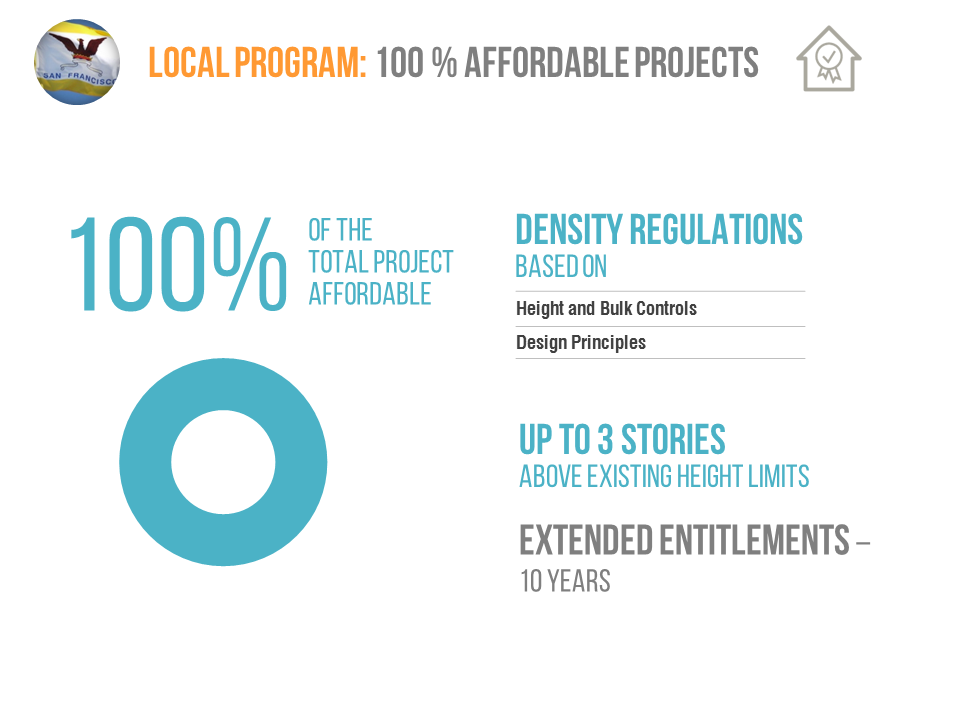
Learn more about the key chapters in the planning process.
|
Winter 2014 |
Housing Working Group 2014 Findings and Recommendations Report |
|
Summer 2015 |
Residential Density Bonus Study Financial Analysis of San Francisco’s Proposed Affordable Housing Bonus Program |
|
Summer/Fall 2015 |
Meetings with Stakeholders, Planning Commission Informational Meeting and Open House Small Sites Analysis Draft Guidelines for Affordable Housing Bonus Program Design |
|
Winter 2015 |
Planning Commission review Land Use Committee review Board of Supervisors review Mayor signs legislation |
Legislation
- Amended Affordable Housing Bonus Program Legislation - January 2016
The September 2015 Draft Affordable Housing Bonus Program legislation is amended and includes several technical changes that respond to community and stakeholder comments. - Proposed Amendments from Supervisor Breed
Supervisor Breed's proposed amendment would prohibit Local AHBP or State-Analyzed AHBP projects to demolish buildings with rent control units. - Draft Affordable Housing Density Bonus Legislation – September 2015
Mayor Lee introduced draft Affordable Housing Density Program legislation at the Board of Supervisors in September, 2015. - State Density Bonus Law
In 1979, the State of California adopted the State Density Bonus Law, which requires all cities and counties to offer a density bonus and other incentives to housing developments.
AHBP Reports and Studies
- Case Report February 25, 2016 Planning Commission Hearing
This case report is intended to provide a structure for the Commission to consider six primary topics. - Case Report January 28, 2016 Planning Commission Hearing
The executive summary provides a summary of the program, issues and considerations, an overview of potential units to be developed over the next 20 years and design guidelines, and an outline of changes to the program since the December 3, 2015 Planning Commission Hearing.- Addendum 3 to the Housing Element Environmental Impact Report
This document is an addendum to the 2004 and 2009 Housing Element FEIR. Its purpose is to substantiate the Planning Department's determination that no supplemental or subsequent environmental review is required prior to adoption of the City and County of San Francisco ("City") Affordable Housing Bonus Program ("proposed program," "proposed project," or "AHBP") and related General Plan amendments.
- Addendum 3 to the Housing Element Environmental Impact Report
- Memo to the Planning Commission 22MB – November 5, 2015 Hearing
The executive summary provides a detailed account of the Affordable Housing Bonus Program (AHBP) background, development, and proposal, as well as discussion of key issues raised by Planning Commissioners and members of the public. - Memo to the Planning Commission - October 15, 2015 Hearing
This report is limited to amending the General Plan to make conforming amendments so that the General Plan better reflects the goals of the Affordable Housing Bonus Program. - Housing Work Group 2014 Findings and Recommendations
Mayor Lee organized a housing working group that included key stakeholders in the housing community: affordable and market-rate housing developers and financiers, City staff, housing advocates, and related stakeholders. - Residential Density Bonus Study – August 2015
David Baker Architects (DBA) modeled over 10 sites in the program area to help determine the physical appearance of buildings that might result if allowed density bonuses or other relief from development standards under a density bonus program. - Affordable Housing Bonus Program: Opportunities Within Small Sites – October 2015
In addition to the protypical sites studied by DBA, OpenScope Studio completed an analysis of smaller lots to understand the physical needs and constraints of projects on 25 and 50 foot wide lots. - Financial Analysis of San Francisco's Proposed Affordable Housing Bonus Program – August 2015
Seifel Consulting tested the program on three sites to determine if the projects were generally financial feasible under the State and the Local Program. - Guidelines for Affordable Housing Bonus Program Design
In order to ensure consistency with the intent of the Planning Code and the General Plan, to construct high quality buildings, and provide project sponsors with guidance, the Planning Commission and City Agencies will use the following guidelines as an evaluating tool for specific project implementation.
Summary Materials
- Planning Commission Presentation - January 28, 2016
The AHBP team followed up on the December 3, 2015 Planning Commission hearing and presented an overview and answered questions regarding the program on January 28, 2016. - Planning Commission Presentation - December 3, 2015
The AHBP team followed up on the November 5, 2015 Planning Commission hearing and presented an overview and answered questions regarding the program on December 3, 2015. - Planning Commission Presentation – November 5, 2015 50MB
The AHBP team presented an overview and answered questions regarding the program on November 5, 2015. - Webinar presentation and video – October 2015
The AHBP team gave give an overview of the Program using the same Open House materials during an informational webinar on October 22, 2015. - Open House - Station Boards and Handouts – October 2015
The AHBP hosted an Open House about the proposed Program's goals and objectives, status, and next steps on October 26, 2015.
Presentations
- To review presentations from past meetings and events, please visit the Meetings and Events tab
Background
- San Francisco Housing Element 2014
The City's Housing Element is required by State law and was updated in 2014. - Inclusionary Housing Ordinance
The City's Inclusionary Housing Program (Section 415 of the SF Planning Code) requires all market-rate residential projects of 10 housing units or more to contribute to San Francisco's affordable housing supply. - City Zoning Map
The Citywide Zoning Map shows the individual zoning districts throughout the city.
Other Resources
- AHBP Frequently Asked Questions
Learn more about the Program and affordable housing efforts in the City. Public Questions and Answers (October to December 2015)
- Document #1 - posted 01/15/16
- Document #2 - posted 01/26/16
These documents provide answers to questions about the Affordable Housing Bonus Program submitted by the public to the Planning Department between October 1, 2015 and December 31, 2015 via email and at community meetings in December 2015 (Planning Association for the Richmond Community Meeting, December 9, 2015; and, District 5 Community Meeting, December 10, 2015).
Learn more about where the Program does and does not apply.
Areas highlighted in blue on the map below illustrate the key residential and commercial corridors where the Affordable Housing Bonus Program applies in the City.
Click on the map image to go to the interactive, searchable map, where the program applies by parcel in the City.
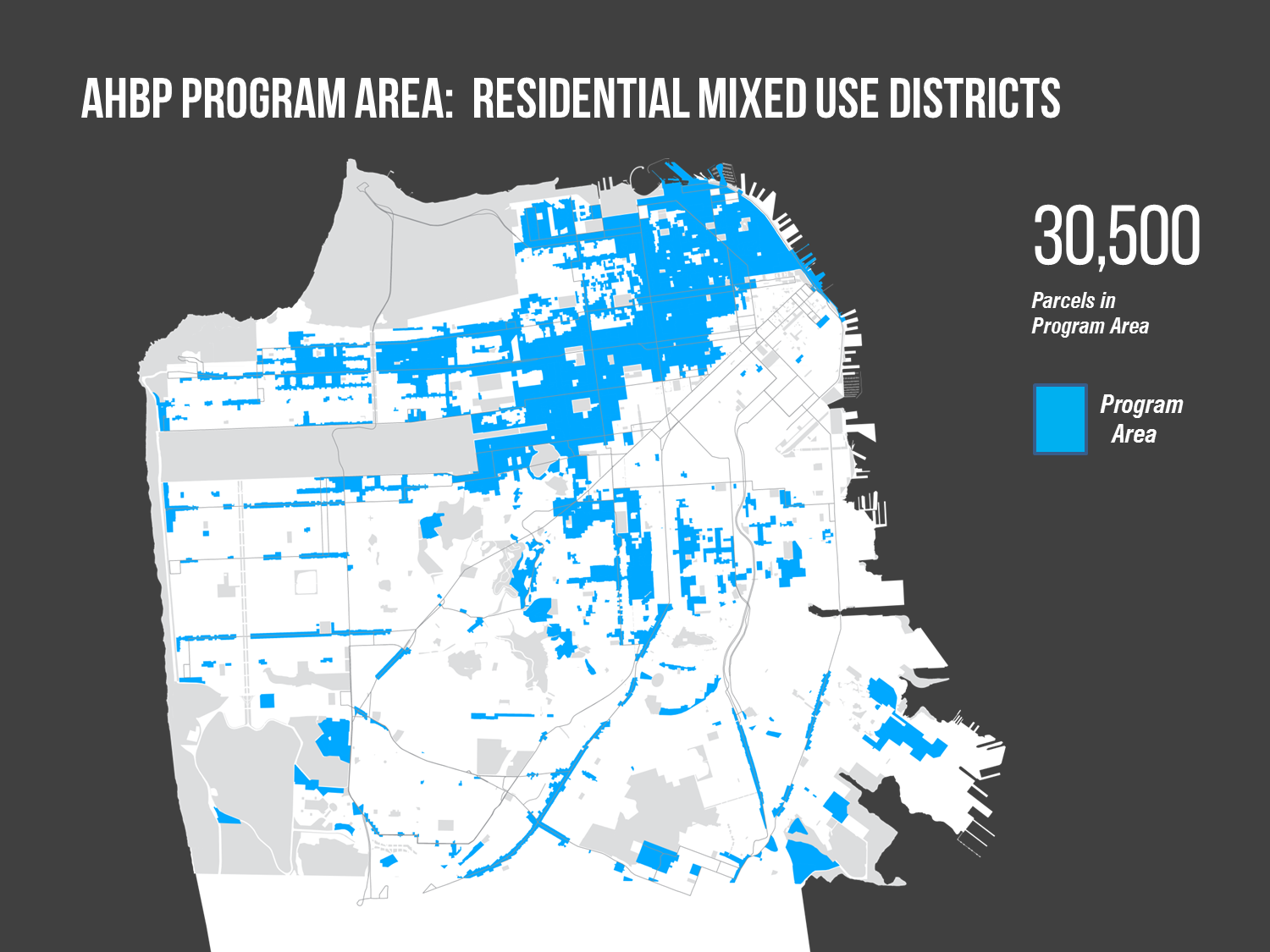
Use the Interactive Map to explore where the program applies by parcel in the City.
Where the Program Applies
The following zoning districts are within the program area. Learn more about these zoning districts by viewing the City’s Zoning Map.
|
|
Where the Program Does Not Apply
Parcels in RH-1(parcels with one housing unit per lot in Residential, House Character Districts) and RH-2 (parcels with two housing units per lot in Residential, House Character Districts) zoning districts are not eligible for this program.
Area Plans (such as the Eastern Neighborhoods Community Plan , Market and Octavia Area Plan, and Balboa Park Station Area Plan, among others) are not eligible for either Local or State AHBPs as they have recently adopted comprehensive plans. The City is currently studying how the State Density Bonus Law would be applied for future projects within these area plan boundaries.
Do you have a specific question regarding the City’s Zoning Map and a Planning Code?
Please contact the Public Information Counter.
Case reports, Ordinance, Motions, Resolutions and Public Hearings by publication date – for those following closely
| Date | Legislation/Resolutions/Motions and Staff Case Reports | Presentation Materials and Video |
|
1979 |
State Density Bonus Law |
|
|
2013 |
|
|
|
November 2014 |
Proposition K passes with 65.6% of the vote, making it official City policy to strive to make 33% of newly constructed housing units to be affordable to low and moderate income households. |
|
|
September 29, 2015 |
Mayor Lee introduced Draft Affordable Housing Density Bonus Legislation legislation at the Board of Supervisors. |
|
|
October 15, 2015 |
Planning Commission Hearing #1: Initiation of General Plan Amendment for AHBP |
|
|
November 5, 2015 |
Planning Commission Hearing #2: Informational Hearing on AHBP |
November 5, 2015 Planning Commission Presentation |
|
December 3, 2015 |
Planning Commission Hearing #3: Informational Hearing on AHBP |
December 3, 2015 Planning Commission Presentation
|
|
January 2016 |
Amended Affordable Housing Bonus Program Legislation |
|
|
January 2016 |
Amendments from Supervisor London Breed |
|
|
January 28, 2016 |
Planning Commission Hearing #4: Adoption Hearing |
January 28, 2016 Planning Commission Presentation |
|
June 13, 2016 |
Board of Supervisors - Land Use Committee |
|
|
June 21, 2016 |
Board of Supervisors Hearing #1 The legislation for the 100% Affordable Program receives several amendments, including:
The item was continued for one week. |
|
|
June 28, 2016 |
Board of Supervisors Hearing #2 The General Plan Amendment was rejected by a 6-5 vote. The City Attorney noted that the Board could have a discussion of the item, but in order to take action, they would require General Plan Consistency findings from the Planning Commission. The legislation for the 100% Affordable Program was further amended to include the following:
The item was continued until July 12th. |
|
|
June 30, 2016 |
Planning Commission Hearing June 30, 2016 Planning Commission Case Report |
|
|
July 12, 2016 |
Board of Supervisors Hearing #3 The 100% Affordable Housing Bonus Program, with the following amendments, was passed with a unanimous vote of 11-0. Amendments:
Include language to specify that the program does not apply in the RH-1(D) district. |
|
|
July 29, 2016 |
Mayor Ed Lee signed the 100% Affordable Housing Bonus ordinance into law on July 29th. |
What is a density bonus?
A density bonus is an increase in the number of housing units and possibly height that are currently allowed under a specific zoning regulation, in exchange for building more affordable housing units and helping the City meet its housing goals.
For example: Under the Affordable Housing Bonus Program (AHBP), if a residential development includes 20 percent affordable housing units on-site, then the development could be granted up to a 35 percent density bonus, allowing for more total housing units than currently allowed. This is also known as an increased density. Or more specifically, an AHBP residential development proposed on a site that currently allows 10 housing units would be permitted to have 14 total housing units on-site, provided at least three of those units are affordable.
What is the State Density Bonus Law?
In 1979, the State of California adopted the State Density Bonus Law, which requires all cities and counties to offer a density bonus and other incentives to housing developments that include at least one of the following options:
- Five percent of total housing units available to very low-income households
- Ten percent of total housing units available to low-income households
- Ten percent of total housing units available to moderate-income households
- A senior citizen or mobile home park that limits residency based on age requirements for older persons
In addition to a density bonus, incentives could include changes in development design requirements such as building setbacks or provided parking.
In 2013, the State Supreme court clarified that any residential development that provides affordable housing units on-site, including those provided to comply with local inclusionary programs, enable project sponsors to request a density bonus under the State Density Bonus Law.
Read the State Density Bonus Law in detail here. Learn more about the 2013 court case here.
What is the City’s Inclusionary Housing Program?
Inclusionary housing is defined as a program that requires a specific portion of new construction to be made affordable to households with low- to moderate- incomes. The City’s Inclusionary Housing Program (Section 415 of the SF Planning Code) requires all market-rate residential projects of 10 housing units or more to contribute to San Francisco’s affordable housing supply. This can happen by:
- Contributing to the City’s Affordable Housing fund commensurate with the number of total project units;
- Building 12 percent of the affordable housing units on-site to low- and moderate-income households; or
- Building 20 percent of the affordable housing units off-site to low- and moderate-income households.
Learn more about the Inclusionary Housing Program.
Due to the 2013 the State court ruling, housing developments in San Francisco that elect to comply with the Inclusionary Housing Ordinance by providing 12 percent affordable housing units on-site may seek a density bonus and other incentives. Learn more about the 2013 California appellate court ruling here.
Why create a Local and State Affordable Housing Bonus Program (AHBP) when the State already published the Density Bonus Law?
The State Density Bonus Law is not extensive enough to meet needs specific to San Francisco and does not incentivize middle-income housing. The AHBP was developed to go above and beyond the State requirements by incentivizing and supporting permanently affordable middle-income housing, while protecting the character of San Francisco’s neighborhoods.
How does the City’s Inclusionary Housing Ordinance work with the Local and State Affordable Housing Bonus Programs?
The Local and State AHBPs build on the existing Inclusionary Housing Ordinance. The chart below highlights the key differences between the Inclusionary Housing Ordinance and the AHBP Local and State Programs.
| San Francisco’s Inclusionary Housing Ordinance | Local AHBP | State AHBP | |
|---|---|---|---|
| Mandatory or Optional | Mandatory | Optional | Optional |
| Minimum Total Number of Housing Units Required | 10 housing units | No minimum unit threshold | Five housing units |
| Required Minimum Percentage of Affordable Housing Units On-site to Participate in the Program | Meet the requirements by:
Building 20 percent of the affordable housing units off-site to very low and low income households. | 30 percent affordable housing units, including: If project has 10 or more units, it is subject to inclusionary housing requirements:
And
Option 2: If project has nine or fewer units it is not subject to inclusionary housing requirements: 30 percent middle-income | 5 – 20 percent affordable housing units, including: Option 1: if project has ten or more units, it is subject to inclusionary housing requirements:
Option 2: If project has nine or fewer units it is not subject to inclusionary housing requirements and must include one or more of the following options:
A senior citizen or mobile home park that limits residency based on age requirements for older persons |
| Additional Affordable Housing Units Required to Qualify for AHBP Density Bonus and Incentives | Not applicable | Not applicable | Up to a cumulative of 20 percent for very low, low, and moderate-income households |
| Total Affordable Housing Units On-Site | 12 percent, if not contributing to Affordable Housing Fund | 30 percent | 5 – 20 percent |
Click on image to enlarge.
Under the AHBP, affordable housing is for very low, low, moderate, and middle-income households. The chart above illustrates how these terms are defined and what professions tend to fall into each category.
AMI: Area Median Income
Area = A particular geographical area, e.g., San Francisco
Median = Middle point: half of the households earn below the median while the other half earn above
Income = Total income of the entire household
- Very-low income households: Earn up to 55 percent of the Area Median Income in San Francisco
- Low-income households: Earn up to 80 percent of the Area Median Income in San Francisco
- Moderate-income households: Earn up to 120 percent of the Area Median Income in San Francisco
- Middle-income households: Earn up to 140 percent of the Area Median Income in San Francisco
Half of the households in San Francisco earn below the AMI while the other half of households earn above the City’s AMI. AMI is set each year by HUD and is based on household size and the income households earn in the area. The City uses these annually published income limits to inform its various housing programs.
The total of all salaries earned by all people living in the same home equals the household’s total annual income. Based on the 2010 American Community Survey (also known as the U.S. Census), the typical San Francisco household has approximately 2.4 people.
See the Mayor’s Office of Housing and Community Development for more information about who qualifies for affordable housing.
What will AHBP developments look like?
In keeping with the character of the neighborhood areas and commercial corridors, AHBP residential developments will be required to place a strong emphasis on ground floor retail (also known as mixed-use buildings). In addition, the AHBP team will develop specific design guidelines that require proposed projects to include elements such as:
- Commercial spaces with active ground floor uses
- Transparent and operable windows, awnings, and informational displays
- Attention to design detail, including variation in material use
Click here for an overview of the existing San Francisco Planning design review process.
The following photos are examples of mixed use-buildings.
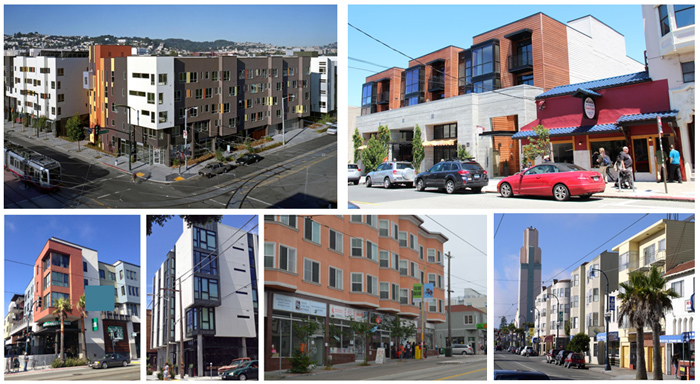
What is the design review process for AHBP developments?
Staff will complete a design review for all projects that elect to participate in either the Local or State AHBP. This review will include the various dimensions of proposed projects, including height, relevant setbacks, and other standard design considerations. Projects will be required to apply design solutions, such as:
- Planting living walls or vines on property line walls
- Window detailing
- Varying the building façade materials and depth from the sidewalk
- Providing an active ground floor
These design elements, among others, will ensure developments blend with adjoining buildings to ensure consistency with neighborhood character.
Will AHBP developments need to pay development impact fees?
Yes. The City imposes impact fees on development projects in order to mitigate the impacts caused by new development on public services, infrastructure, and facilities. For example, new residential and commercial projects pay impact fees to offset burdens placed on transit systems and sidewalks. Some impact fees apply to various types of development projects throughout the City, while others apply only in certain neighborhoods.
Learn more about the City’s Development Impact Fees.
When will Affordable Housing Bonus Program legislation be introduced and what is the process?
The legislation is scheduled to be introduced in the fall of 2015. Once legislation is introduced it will be publicly available through the Clerk of the Board and San Francisco Planning. The proposed legislation will trigger changes to the Planning Code and will be reviewed by the:
- Planning Commission (one meeting)
- Land Use Committee of the Board of Supervisors (one meeting)
- Board of Supervisors (two meetings)
- Mayor Lee signs for final approval
These meetings will be publicly noticed. To learn more, please sign up on the AHBP mailing list by emailing: CPC.AHBP@sfgov.org or visit our website here to learn about meetings and events.
What other City programs encourage affordable housing?
San Francisco has several other programs designed to create new affordable housing, protect the existing housing supply, and encourage higher levels of affordable housing through development incentives, such as:
Other programs include:
See the Mayor’s Office of Housing and Community Development, the Office of Community Investment and Infrastructure, and the San Francisco Housing Authority for more information and a complete listing of all programs.
Other questions received
Have you submitted specific a specific question? These documents provide answers to questions about the Affordable Housing Bonus Program submitted by the public to the Planning Department between October 1, 2015 and February 23, 2016.
Older versions: Document #1 - posted 01/15/16 and Document #2 - posted 01/26/16
Questions from the Open House: Questions and Answers
Richmond: Public Questions and Answers
District 5: Public Questions and Answers
District 7: Community Event Questions and Answers
Learn about the State Density Bonus Law, the 2014 Housing Element, the Inclusionary Housing Ordinance and Proposition K.
State Density Bonus Law
In 1979, the State of California adopted the State Density Bonus Law, which requires all cities and counties to offer a density bonus and other incentives to housing developments that include at least one of the following options:
- Five percent of total housing units available to very low-income households
- Ten percent of total housing units available to low-income households
- Ten percent of total housing units available to moderate-income households
- A senior citizen or mobile home park that limits residency based on age requirements for older persons
A density bonus is an increase in the number of housing units than are currently allowed under a specific zoning regulation in exchange for building more affordable housing units and helping the City meet its housing goals. In addition to a density bonus, incentives could include changes in development design requirements such as building setbacks or provided parking.
In 2013, the State Supreme court clarified that any residential development that provides affordable housing units on-site, including those provided to comply with local inclusionary programs, enable project sponsors to request a density bonus under the State Density Bonus Law.
Proposed Affordable Housing Bonus Program
The AHBP was developed to go above and beyond the State requirements by incentivizing and supporting permanently affordable middle-income housing, while protecting the character of San Francisco’s neighborhoods.
The proposed Affordable Housing Bonus Program:
- Implements the 2014 Housing Element
- Builds on the City’s Inclusionary Housing Ordinance
- Helps the City meet the housing goals mandated in Proposition K
2014 Housing Element
In April 2014, San Francisco Planning updated the City’s Housing Element. This recent update includes Implementation Measure 38b, recommending the development of an Affordable Housing Bonus Program.
Implementation Measure 38b: Planning will develop a density bonus program with the goal of increasing the production of affordable housing. The program will be structured to incentivize market rate projects to provide significantly greater levels of affordable housing than required by the existing City Programs.
Inclusionary Housing Ordinance
The AHBP builds on the existing Inclusionary Housing Ordinance to support the development of a greater number of on-site affordable units. The City’s Inclusionary Housing Ordinance (Section 415 of the SF Planning Code) requires all market-rate residential projects of 10 housing units or more contribute to San Francisco’s affordable housing supply. This can happen by:
- Contributing to the City’s Affordable Housing fund commensurate with the number of total project units;
- Building 12 percent of the affordable housing units on-site to low and moderate-income households; or
- Building 20 percent of the affordable housing units off-site to low and moderate-income households.
Proposition K
In November 2014, San Francisco voters passed Proposition K, which established an additional affordable housing policy goal of constructing or rehabilitating at least 30,000 housing units by 2020, 33 percent of which are to be affordable housing available to low and moderate‐income households. More than 50 percent of the affordable housing units will be available to middle-income households, with at least 33 percent affordable for low and moderate-income households.
| AHBP Architectural Study David Baker Architects (DBA) modeled over 10 sites in the program area to help determine the physical appearance of buildings that might result if allowed density bonuses or other relief from development standards under a density bonus program. | Residential Density Bonus Study – August 2015 |
| AHBP Architectural Study – AHBP on Small Lots In addition to the protypical sites studied by DBA, OpenScope Studio completed an analysis of smaller lots to understand the physical needs and constraints of projects on 25 and 50 foot wide lots. | Affordable Housing Bonus Program: Opportunities Within Small Sites – October 2015 |
| AHBP Financial Feasibility Study Seifel Consulting tested three sites to determine if projects were generally financial feasible under the State and the Local Programs of AHBP. | Financial Analysis of San Francisco’s Proposed Affordable Housing Bonus Program – August 2015 |
| AHBP Potential Soft Site Memo This memo, which includes a map and list of sites, details the soft site analysis the Planning Department used to estimate the potential impact of the Affordable Housing Bonus Program. | Affordable Housing Bonus Program Potential Soft Sites – February 22, 2016 |
| Mayor’s Housing Working Group Mayor Lee organized a housing working group that included key stakeholders in the housing community: affordable and market-rate housing developers and financiers, City staff, housing advocates, and related stakeholders. | Housing Work Group 2014 Findings and Recommendations |
| San Francisco General Plan - Housing Element The AHBP supports objectives, policies and implementation measures identified in the Housing Element, an element of the City’s General Plan that guides long range housing policy. The Element was developed with input from a BOS appointed 16-person Community Advisory Body, vetted in over 30 meetings hosted by neighborhood organizations, and adopted by the Planning Commission and Board of Supervisors. | San Francisco Housing Element (updated 2014) |
| Inclusionary Housing Ordinance The City’s Inclusionary Housing Program (Section 415 of the SF Planning Code) requires all market-rate residential projects of 10 housing units or more to contribute to San Francisco’s affordable housing supply. | Inclusionary Housing Ordinance |
| San Francisco Zoning Map The Citywide Zoning Map shows the individual zoning districts throughout the city. | City Zoning Map |
Past Meetings and Events
- August 11, 2015 - SPUR
- August 14, 2015 - San Francisco Housing Action Coalition
- August 24, 2015 - Coalition for San Francisco Neighborhoods
- August 26, 2015 - Council of Community Housing Organizations
- September 15, 2015 - Coalition for San Francisco Neighborhoods
- September 15, 2015 - Residential Builders Association of San Francisco
- October 22, 2015 - Webinar
- Webinar presentation PDF
- Webinar on Video 190MB WMV File
- Background (minute 3:20-23:30)
- The Basics (23:40-29:10)
- The Proposed Program (29:20-42:40)
- Design Guidelines and Small Site Opportunities (43:00-51:10)
- Outcomes, Timeline, and Next Steps (51:20-56:30)
- Questions and Answers (56:40-1:17:00)
- October 26, 2015 - Open House, City Hall
- October 29, 2015 - Democratic Club, the Outer Sunset Parkside Residents Association, and Supervisor Katy Tang
- November 5, 2015 - Planning Commission
- Planning Commission Presentation - 11/05/15 50MB
- Commission Hearing (video) - Agenda item #11
- November 16, 2015 - Eastern Neighborhoods Citizens Advisory Committee
- November 16, 2015 - Market & Octavia Advisory Committee
- November 24, 2015 - SF Group of the Sierra Club
- December 3, 2015 - Planning Commission review
- Presentation
- Video of Hearing (see agenda item #11) - Note: this video will only be available for 18 months from date of broadcast.
- December 9, 2015 - Community Meeting, Richmond
- December 10, 2015 - Community Meeting, District 5
- January 6, 2016 - Bayview CAC Community Meeting, District 10
- January 6, 2016 - Community Meeting, District 2
- January 12, 2016 - Community Meeting, District 7
- January 14, 2016 - Community Meeting - District 3
- January 19, 2016 - Community Meeting - District 4
- January 21, 2016 - Community Meeting - District 8
- January 23, 2016 - Community Meeting - District 1
- January 25, 2016 - Community Meeting - Alamo Square Neighborhood Association
- January 26, 2016 - Presentation to SF Bay Area Renters' Federation
- January 28, 2016 - Planning Commission Presentation
- February 8, 2016 - Small Business Commission, City Hall
- February 16, 2016 - Community Meeting - Districts 11 and 9
- Monday, February 22, 2016 - Community Meeting - District 10
- Thursday, February 25, 2016 - Planning Commission Hearing
